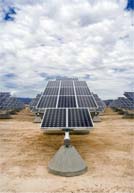U.S. military to install 3 gigawatts of renewable energy
 Dorothy Robyn, the U.S. Department of Defense’s (DOD’s) deputy undersecretary of defense for Installations and Environment, discussed how the U.S. military is adding in solar, renewables and energy efficiency to increase its energy security. Robyn, who opened up the second day of the World Renewable Energy Forum, is in charge of the department’s transition to renewable energy and energy efficiency. The Army, Air Force and Navy have agreed to install a total of 3 gigawatts of new renewable energy by 2025. That’s on top of other commitments the department is making to decrease its ravenous appetite for fuel.
Dorothy Robyn, the U.S. Department of Defense’s (DOD’s) deputy undersecretary of defense for Installations and Environment, discussed how the U.S. military is adding in solar, renewables and energy efficiency to increase its energy security. Robyn, who opened up the second day of the World Renewable Energy Forum, is in charge of the department’s transition to renewable energy and energy efficiency. The Army, Air Force and Navy have agreed to install a total of 3 gigawatts of new renewable energy by 2025. That’s on top of other commitments the department is making to decrease its ravenous appetite for fuel.
The Department also is making other commitments, ranging from energy efficiency new buildings and retrofits to testing new technologies to determine best of class. It makes sense given recent energy trends. “Facility energy is about 20 percent of total energy cost,” Robyn said. She added that the department’s energy bill went up dramatically from 2010 and 2011, mostly because of increased energy prices. So the department, which consumes one percent of all the energy in the U.S., is fighting back by becoming leaner and greener.
Only problem is there’s an awful lot of it to put on an energy diet. After all it has 300,000 buildings, Robyn said. “That’s three times the footprint of all the Walmart stores,” Robyn said. It also has plenty of land. “We manage 28 million acres of land. Most is used for testing and training.” But some of it is ideal for renewable energy, like wind, solar or geothermal.
Each of the armed forces has committed to implementing 1 gigawatt of renewables by 2025 at the latest. With most of it coming from private financing so the installers can share benefits with the military that it otherwise would be ineligible for.
The Air Force taking the most aggressive stance, planning to reach that level by 2016. The department has installed solar at some of its bases including Nellis Air Force Base, which has a 14 megawatt array. “They're doubling capacity at Nellis. They are looking to do a humungous solar project at Edwards Air Force Base of several 100 megawatts,” Robyn said. The Air Force is looking among other things, to enhanced use leases to help it install more renewables quickly.
The Navy is committed to 1 gigawatt of renewables by 2020. “It just broke ground on a 14 megawatt PV facility at China Lake, SunPower is the developer,” Robyn said. It was the first contract under a new rule that allowed the Navy to sign a power-purchase agreement for up to 30 years. She called it painful, but was looking forward to more such contracts in the future.
The Navy’s also working on a similar contract at Pearl Harbor. It’s being built on the Ford Island runway. “The arrays will be flat, not tilted. That, together with the markings it will look like a runway when seen from the air, with yellow 'X's' every 1,000 feet to tell pilots this is not a working runway,” Robyn said.



